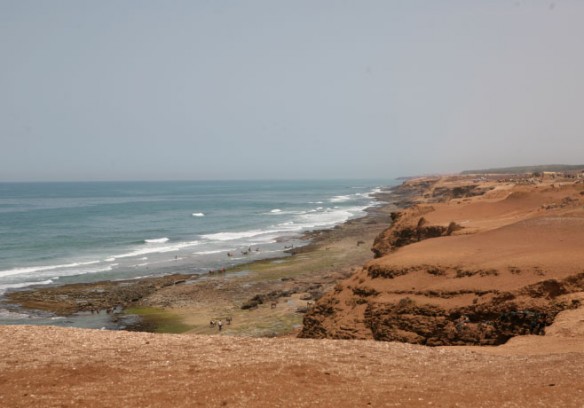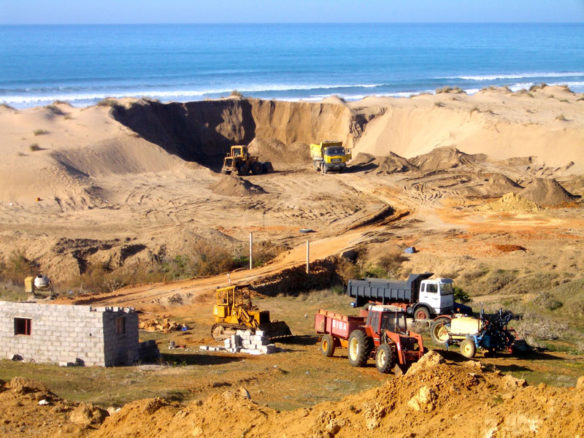
Results of an intensively sand mined beach and shoreline, near Larache, Morocco, Northern Africa. Sand miners at the water edge, donkeys, and sand lorries up cliff, are seen in the background.
Blond and beautiful expanses of beach sand and once spectacular coastal dunes – some of which towered up to 60 meters high – have disappeared, revealing now a bare landscape. Captions and Photograph: © SAF — Coastal Care
“Sand is the second most consumed natural resource, after water…” —Denis Delestrac -(©-2013) “Sand Wars” Multi Award-Winning Filmmaker.
Excerpts;
Des filières légales et clandestines se disputent le sable nécessaire à la confection du béton. Le trafic est tel que des plages entières sont menacées de disparition.
Du haut de ses 11 ans, Karim fait mine de ne rien sentir. Ni le poids des charges qui épuisent son corps frêle ni les brûlures du soleil sur sa peau. Six jours par semaine, le petit garçon se rend au bord de la mer, à une vingtaine de kilomètres de Larache, dans le nord du Maroc. Autour de lui, face à l’Atlantique, la plage a disparu : il n’y a plus un grain de sable sur le rivage. Comme une dizaine d’autres gamins, Karim doit s’avancer vers l’océan une pelle à la main et prendre de pleines pelletées de sable mouillé, qui sera transporté ensuite à dos d’ânes vers le sommet de la falaise. Huit heures d’allers-retours éreintants l’attendent chaque jour.
Le long du littoral marocain, les « marchands de sable », maîtres-d’œuvre d’un business semi-mafieux, recrutent ainsi des centaines d’enfants. « Des fourmis face aux filières organisées qui disposent de gros moyens et du soutien des autorités pour dépouiller les plages », explique un fin connaisseur de ce milieu. Karim, lui, assure travailler « pendant les vacances d’été ». Mais vont-ils vraiment à l’école le reste de l’année ?
D’après les habitants des villages alentours, le trafic ne cesse jamais…
Translation:
Legal and illegal sand miners are competing in the race to provide sand for use in the construction industry. The traffic is such that entire beaches are disappearing.
At only 11 years-old, Karim is pretending not to suffer from anything – not from the heavy loads his frail frame has to carry, nor the burning bite of the sun on his skin. Six days a week, the young boy goes by the sea, at a 20 kilometers distance from the town of Larache, North Morocco. Around him, as he is standing at the edge of the Atlantic ocean, the beach has disappeared: all grains of sand have vanished from the shore. Like a dozen of other kids, shovel in hand, Karim is to walk knee-high into the ocean to scoop out wet sand, to be loaded into bags then carried up the cliffs by a herd of donkeys. Eight hours of exhausting runs up and back down are making his day of work, each days.
All along the moroccan shoreline, heads of such beach mining operations, for the most part involved with the sand mafia, hire hundreds of helpless young boys to do the pillaging work for their own profit.
Meanwhile, Karim affirms he is working “only during summer break”. But do these children really go to school all year long…?
According to the local villagers surrounding the sites, the beach sand mining activities never cease…
Why are beaches disappearing in Morocco? By Matthew Greene (08-05-2016)
The Sand Thieves of Larache, Northern Morocco; VICE Magazine (10-14-2015)
The Market For African Beach Sand: Who’s Buying, Selling And Mining It? AFK Insider (02-17-2017)
Sand mining on beaches and in riverbeds is a source of income for unemployed Africans, but it’s often an unregulated — or under-regulated — business. Environmental impact is a growing concern…
The Conservation Crisis No One Is Talking About, By John R. Platt, TakePart (09-21-2016)
Beaches around the world are disappearing. No, the cause isn’t sea-level rise, at least not this time. It’s a little-known but enormous industry called sand mining, which every year sucks up billions of tons of sand from beaches, ocean floors, and rivers to make everything from concrete to microchips to toothpaste…
Sand Is in Such High Demand, People Are Stealing Tons of It, By Dave Roos; HowStuffWorks (03-06-2017)
As strange as it may sound, sand is one of the world’s hottest commodities. The global construction boom has created an insatiable appetite for sand, the chief ingredient for making concrete. The problem is that sand isn’t as abundant as it used to be. And when high demand and high value meets scarcity, you open the doors to smuggling…
The Economist explains: Why there is a shortage of sand; The Economist (04-24-2017)
It may be plentiful, but so is the demand for it…
Sand, Rarer Than One Thinks: A UNEP report (GEA-March 2014)
Despite the colossal quantities of sand and gravel being used, our increasing dependence on them and the significant impact that their extraction has on the environment, this issue has been mostly ignored by policy makers and remains largely unknown by the general public.
In March 2014 The United Nations released its first Report about sand mining. “Sand Wars” film documentary by Denis Delestrac – first broadcasted on the european Arte Channel, May 28th, 2013, where it became the highest rated documentary for 2013 – expressly inspired the United Nations Environment Programme (UNEP) to publish this 2014-Global Environmental Alert.
Sand Wars, An Investigation Documentary, By Multi Award-Winning Filmmaker Denis Delestrac (©-2013)
As of 2011-2012, when investigative filmmaker Denis Delestrac and team, were collecting and unveiling sand mining datas and information from the professionals involved, “…the sand business was estimated to be a $70 billion industry, worldwide…!”—Denis Delestrac (©-2013)
Sand Mining in Morocco: Learn More, Coastal Care
Global Sand Mining: Learn More, Coastal Care
BE THE CHANGE:
PETITION: Take Action To End Global Beach Sand Mining, Coastal Care

Illegal beach and dune sand mining operations, near Tangier, Morocco. Photograph: © SAF — Coastal Care









